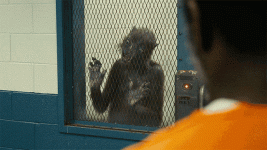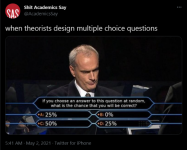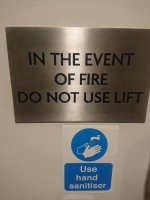-
Features
-
Friends of IIDBFriends Recovering from Religion United Coalition of Reason Infidel Guy
Forums Council of Ex-Muslims Rational Skepticism
Social Networks Internet Infidels Facebook Page IIDB Facebook Group
The Archives IIDB Archive Secular Café Archive
You are using an out of date browser. It may not display this or other websites correctly.
You should upgrade or use an alternative browser.
You should upgrade or use an alternative browser.
Images that make you laugh
- Thread starter gmbteach
- Start date
- Joined
- Oct 22, 2002
- Messages
- 46,891
- Location
- Frozen in Michigan
- Gender
- Old Fart
- Basic Beliefs
- Don't be a dick.
Politesse
Lux Aeterna
- Joined
- Feb 27, 2018
- Messages
- 16,427
- Location
- Tauhalamme/Laquisimas
- Gender
- nonbinary
- Basic Beliefs
- Jedi Wayseeker
Atheos
Veteran Member
Nah, it's more like a quartadox.
- Joined
- Oct 22, 2002
- Messages
- 46,891
- Location
- Frozen in Michigan
- Gender
- Old Fart
- Basic Beliefs
- Don't be a dick.
George S
Veteran Member
Using test-taking theory. Assumption: There is one correct answer. A and D are ruled out; they are the same. Randomly selecting B 1/4 of the time guarantees it is incorrect. This leaves C as the only choice.
Checking our work. In a 4 question test with one correct answer it will be chosen 1/4 of the time. A or D (the correct? answer) will be chosen 1/2 the time. So C is correct. But this means that a correct? answer will be chosen 3 times out of 4. So the assumption of one correct answer is false.
Or it is a paradox. Or a horribly worded question.
bilby
Fair dinkum thinkum
- Joined
- Mar 6, 2007
- Messages
- 40,286
- Gender
- He/Him
- Basic Beliefs
- Strong Atheist
- Joined
- Oct 22, 2002
- Messages
- 46,891
- Location
- Frozen in Michigan
- Gender
- Old Fart
- Basic Beliefs
- Don't be a dick.
Jayjay
Contributor
- Joined
- Apr 7, 2002
- Messages
- 7,173
- Location
- Finland
- Basic Beliefs
- An accurate worldview or philosophy
The question does not specify that the answer has to be one of the four ones provided. I wonder what WWTBAM rules say about contestants answering outside the options?
Using test-taking theory. Assumption: There is one correct answer. A and D are ruled out; they are the same. Randomly selecting B 1/4 of the time guarantees it is incorrect. This leaves C as the only choice.
Checking our work. In a 4 question test with one correct answer it will be chosen 1/4 of the time. A or D (the correct? answer) will be chosen 1/2 the time. So C is correct. But this means that a correct? answer will be chosen 3 times out of 4. So the assumption of one correct answer is false.
Or it is a paradox. Or a horribly worded question.
bilby
Fair dinkum thinkum
- Joined
- Mar 6, 2007
- Messages
- 40,286
- Gender
- He/Him
- Basic Beliefs
- Strong Atheist
Atheos
Veteran Member
The question does not specify that the answer has to be one of the four ones provided. I wonder what WWTBAM rules say about contestants answering outside the options?
Using test-taking theory. Assumption: There is one correct answer. A and D are ruled out; they are the same. Randomly selecting B 1/4 of the time guarantees it is incorrect. This leaves C as the only choice.
Checking our work. In a 4 question test with one correct answer it will be chosen 1/4 of the time. A or D (the correct? answer) will be chosen 1/2 the time. So C is correct. But this means that a correct? answer will be chosen 3 times out of 4. So the assumption of one correct answer is false.
Or it is a paradox. Or a horribly worded question.
I think it's a brilliantly worded question, worthy of entry in the djinn hall of fame.
- If there were 4 options, all different and one of them was 25% that would be the correct answer. But that's not the case.
- Since there are 2 options that say 25% then one has a 50% chance of randomly picking the correct answer, but unfortunately there is only 1 option that says 50%, which you still only have a 25% chance of selecting randomly.
- This means you have a 0% chance of "being correct" by picking an answer at random. But unfortunately one of the options is 0%, and if you pick it you've picked the correct answer, which means your chances of being correct are greater than 0%.
It's the Kobayashi Maru of multiple choice questions.

Elixir
Made in America
It's the Kobayashi Maru of multiple choice questions.
SHOW YOUR WORK!
skepticalbip
Contributor
- Joined
- Apr 21, 2004
- Messages
- 7,304
- Basic Beliefs
- Everything we know is wrong (to some degree)
The question was: If you choose an answer to this question at random, what is the chance that you will be correct?
There isn't one answer. There are two answers.
..If the answer is 25% then there is a 50% chance of randomly choosing correctly.
..If the answer is either 0% or 50% there will be a 25% chance of randomly choosing correctly.
There isn't one answer. There are two answers.
..If the answer is 25% then there is a 50% chance of randomly choosing correctly.
..If the answer is either 0% or 50% there will be a 25% chance of randomly choosing correctly.
Elixir
Made in America
The question was: If you choose an answer to this question at random, what is the chance that you will be correct?
There isn't one answer. There are two answers.
If there are two answers, then your chances are 50/50.
But how do you know there are two answers? Show your work!
skepticalbip
Contributor
- Joined
- Apr 21, 2004
- Messages
- 7,304
- Basic Beliefs
- Everything we know is wrong (to some degree)
The question was: If you choose an answer to this question at random, what is the chance that you will be correct?
There isn't one answer. There are two answers.
If there are two answers, then your chances are 50/50.
But how do you know there are two answers? Show your work!
...You clipped my work...
Elixir
Made in America
The question was: If you choose an answer to this question at random, what is the chance that you will be correct?
There isn't one answer. There are two answers.
If there are two answers, then your chances are 50/50.
But how do you know there are two answers? Show your work!
...You clipped my work...
It needed a trim.
But, on the lighter side:

C_Mucius_Scaevola
Veteran Member
- Joined
- Oct 22, 2002
- Messages
- 46,891
- Location
- Frozen in Michigan
- Gender
- Old Fart
- Basic Beliefs
- Don't be a dick.









